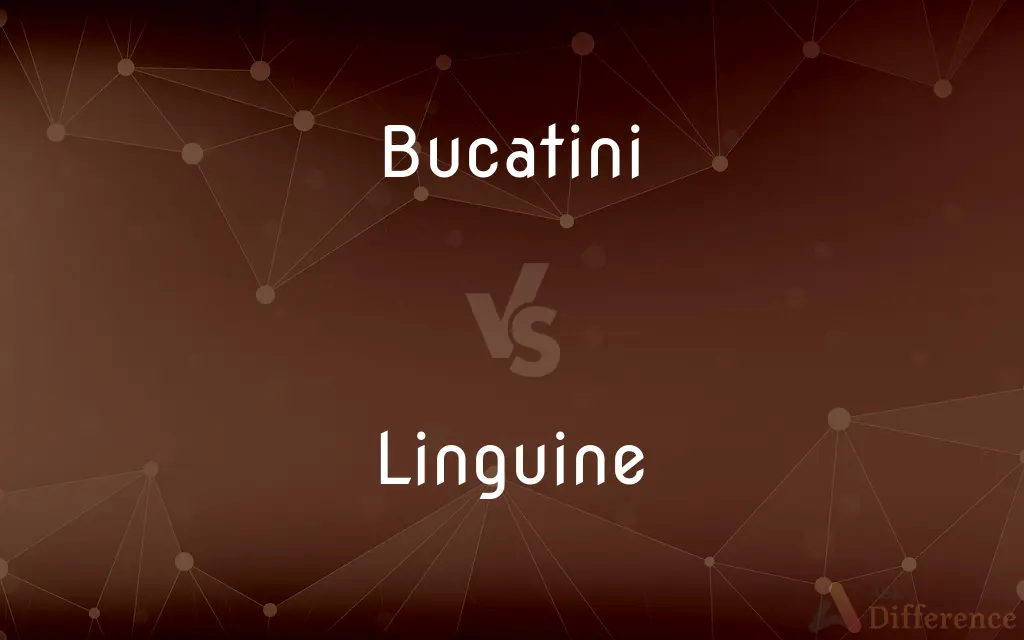Bucatini vs. Linguine — What's the Difference?
By Tayyaba Rehman & Urooj Arif — Updated on May 9, 2024
Bucatini, a thick, hollow spaghetti-like pasta, is ideal for hearty, thicker sauces due to its tube-like structure, whereas linguine, a flat and narrow pasta, pairs well with lighter, smoother sauces.

Difference Between Bucatini and Linguine
Table of Contents
ADVERTISEMENT
Key Differences
Bucatini is a type of pasta resembling thick spaghetti but distinguished by its hollow center, known as the "buco" or hole. This unique structure allows bucatini to hold onto hearty and rich sauces, like Amatriciana, effectively. On the other hand, linguine, which is similar to spaghetti but flatter and wider, is traditionally served with lighter, often seafood-based sauces, such as pesto or vongole.
Bucatini’s robustness makes it suitable for dishes that require a bit more bite and texture in the pasta, allowing the sauce to be absorbed both inside and outside the noodle. Conversely, linguine’s flat surface makes it adept at clinging to thinner, oil-based sauces, providing a different mouthfeel and sauce distribution.
In terms of origin, both pastas hail from Italy, with bucatini often associated with Rome and its rich culinary history. Linguine, however, is linked more with the northern regions of Italy, especially Liguria.
The choice between bucatini and linguine often depends on the desired interaction between pasta and sauce—bucatini for thicker, meatier sauces and linguine for delicate, smooth sauces.
Comparison Chart
Shape
Thick, hollow tubes
Flat, narrow ribbons
ADVERTISEMENT
Best Sauces
Thick, hearty (e.g., Amatriciana)
Light, smooth (e.g., seafood, pesto)
Texture
Firm, holds texture well
Lighter, smooth
Origin
Rome, Italy
Liguria, Italy
Sauce Interaction
Absorbs sauce inside and outside
Clings to sauces without absorbing them
Compare with Definitions
Bucatini
Hollow Pasta.
Bucatini is known for its hollow center that traps sauce.
Linguine
Flat Pasta.
Linguine is a flat, narrow pasta ideal for thinner sauces.
Bucatini
Textured Pasta.
Bucatini's thick and hollow shape adds texture to every bite.
Linguine
Seafood Pasta.
Linguine is frequently used in seafood dishes like Linguine alle Vongole.
Bucatini
Sauce Absorption.
Bucatini's design allows it to absorb sauces both internally and externally.
Linguine
Sauce Adherence.
Linguine’s flat surface helps it adhere to smooth, oil-based sauces.
Bucatini
Roman Cuisine.
In Roman cuisine, bucatini is often featured in classic dishes like Bucatini all'Amatriciana.
Linguine
Ligurian Speciality.
In Liguria, linguine is commonly paired with fresh pesto sauce.
Bucatini
Hearty Sauce Companion.
Bucatini pairs well with rich, meaty sauces due to its thickness.
Linguine
Smooth Texture.
Linguine’s smooth texture complements delicate sauces.
Bucatini
Bucatini (Italian: [bukaˈtiːni]), also known as perciatelli (Italian: [pertʃaˈtɛlli]), are a thick spaghetti-like pasta with a hole running through the center. They are common throughout Lazio, particularly Rome.
Linguine
Linguine (; Italian: [liŋˈɡwiːne]) is a type of pasta similar to fettuccine and trenette but elliptical in section rather than flat. It is about 4 millimetres (0.16 in) in width, which is wider than spaghetti but not as wide as fettuccine.
Bucatini
Pasta in the shape of small tubes.
Linguine
Small pieces of pasta in the form of narrow ribbons.
Bucatini
Pasta in long, hollow strands.
Linguine
Pasta in long, flat, thin strands.
Bucatini
A thicker form of spaghetti with a hole running through it.
Linguine
Of pasta, cut from a sheet, not as wide as tagliatelle.
Linguine
Pasta in long slender flat strips
Common Curiosities
What is the main difference in texture between bucatini and linguine?
Bucatini is thicker with a hollow center, providing a chewier texture, whereas linguine is smoother and flatter.
What type of sauce is best with bucatini?
Bucatini is best with thick, hearty sauces like tomato or meat-based sauces.
Can bucatini be used for light sauces?
While possible, bucatini's thickness and texture are better suited for thicker sauces.
Is linguine suitable for heavy sauces?
Linguine is better with lighter sauces as heavy sauces can overwhelm its delicate structure.
What dishes are traditional with bucatini?
Bucatini all'Amatriciana and Bucatini alla Carbonara are traditional dishes using this pasta.
Why is linguine often served with seafood?
Linguine pairs well with lighter, oil-based sauces, making it ideal for seafood dishes.
Can I substitute bucatini for linguine in recipes?
Substitutions can work but expect a change in how the sauce interacts with the pasta.
How should linguine be cooked for the best results?
Linguine should be cooked al dente, or firm to the bite, to best hold onto sauces.
Which pasta is better for a quick meal?
Linguine cooks slightly faster and is suitable for quick, simple sauces like garlic and oil.
What makes bucatini unique in pasta dishes?
Bucatini's hollow center makes it unique for absorbing and holding onto sauces.
Share Your Discovery

Previous Comparison
Grovel vs. Beg
Next Comparison
Curd vs. WheyAuthor Spotlight
Written by
Tayyaba RehmanTayyaba Rehman is a distinguished writer, currently serving as a primary contributor to askdifference.com. As a researcher in semantics and etymology, Tayyaba's passion for the complexity of languages and their distinctions has found a perfect home on the platform. Tayyaba delves into the intricacies of language, distinguishing between commonly confused words and phrases, thereby providing clarity for readers worldwide.
Co-written by
Urooj ArifUrooj is a skilled content writer at Ask Difference, known for her exceptional ability to simplify complex topics into engaging and informative content. With a passion for research and a flair for clear, concise writing, she consistently delivers articles that resonate with our diverse audience.
















































